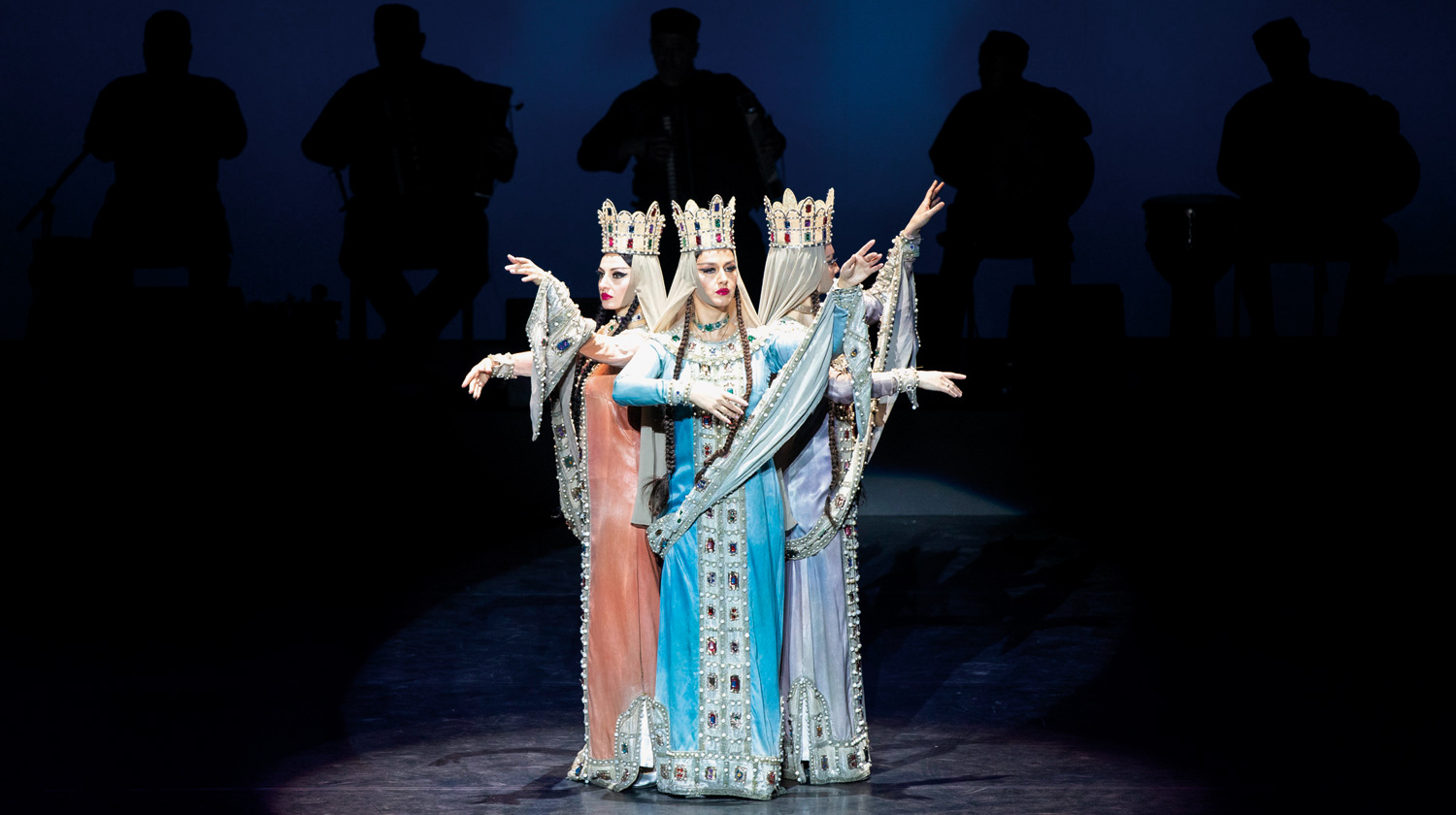

THE Royal Opera House Muscat was sold out and packed to capacity on Friday night in anticipation of the prestigious world-renowned Georgian National Ballet, the ‘Sukhishvili’ dance troupe. Fifty dancers and seven musicians thrilled and astounded audiences for two exclusive performances last weekend with their breathtaking technique, strength and incredible timing. Each composition was performed with the Sukhishvili Ensemble spread across the back of a sparse stage, under monochrome back lighting.
‘Juta’, describing horse thieves in a new choreography based on traditional folk movements, introduced the whole company in red and black costumes, including soft black boots and woollen hats. To accordion and bass guitar accompaniment the men hurtled on stage leaping high, twirling, springing to incredible heights or landing on their knees in quartet formation.
‘Kartuli’ was an authentic traditional dance for three couples in an expression of Georgian chivalry. The women in Gazyr dress were more sedate and graceful in their gliding movement to Levan Kurtanidze’s Duduki solo – a double-reed oboe-like instrument.
‘Khorumi’, an ancient warfare dance featured 24 men of the troupe in black, bathed in red light, with stunning athletic feats of character-ballet perfectly synchronised – reflecting many years of strenuous training. It was accompanied by a beautiful flute melody, fiddle sounds from two accordions and electric bass.

Greek accompaniment, with Giorgi Enukashvili on Panduri (Caucasian three-stringed mandolin), Duduki and bass, the rhythm and movement built up to a fast, folk jig climax.
“Tsdo” was a tour-de-force from the men in chokha coats with virtuoso solos and synchronised leaping, stomping, spinning and bouncing on their knees, to high leaps and double twirls in finely synchronised duets, all to repeated rhythmic patterns from the two doli (traditional drum). Imagine the energy of River Dance combined with complicated dance sequences and complex footwork such as fast, repeated ‘emboîté’.
In complete contrast and one of the iconic productions of Sukhishvili is, ‘Samaia’, bringing to life a 12th century fresco of King Tamar – the first female King. To a repeating clarinet motif, the three soloists in pale flowing gowns and crowns glided effortlessly in an evocative waltz, suggesting ladies of a medieval castle.
The Finale of Act One, ‘Khevsuruli’ from the mountain regions, looked like battle clashes with swords and shields. It portrayed bravery and courage from the company to a repetitive drum beat. The ladies entered with imperceptible tiny steps, then launched into spinning in rural costume with shoes now, not boots.
The men turned their swords to percussive effect as they leapt, airborne at dizzy heights, spinning with all the masculine prowess imaginable. The folk music became faster and faster with dancers expertly wielding their weapons in breathtaking choreographed sword fighting.
Part Two saw 24 men under a full moon perform, ‘Svanuri’ to a winding oboe-like melody with drums. Virtuoso soloists performed to rhythmic hand-claps, or all the men strutted on the knuckles of their toes in perfect synchronisation.
It was followed with some relief by four women in white, brown and black, gliding in hypnotic trance formation in a modern, sensual choreography.
The melody of ‘Nanila’, an ancient lullaby from Svaneti, was given a contemporary interpretation.
‘Tamashi’ was a new choreography by Artistic Director and chief choreographer, Iliko Sukhishvili Jr, grandson of the founder. To tribal drum beats throughout, the men in white sheepskin headgear and knee pads were spinning and landing on their knees, soloists leapt from their knees to points with impossible technique and strength. Women shadowed the men’s footwork in colourful peasant costume in top-lit, evocative ‘pas de deux’ reinterpretations of traditional folk dances.
An instrumental interlude provided a chance to hear the traditional acoustic instruments of the Ensemble, undistracted. Paata Gabunia played a compelling riff on his fretless bass with strummed mandolin and flute, ending with an impressive drum duet in changing rhythms and fast finger work.
‘Ilouri’ was a fascinating ‘pas de quatre’, originally created by the founders of the Georgian National Ballet, Nino Ramishvili and Iliko Sukhishvili in 1945, two women dressed as men performed the same steps and movements. It reinterpreted a Lekuri dance in Caucasian dress using classical ballet technique.

‘Simdi’ was a wedding dance using mirroring symmetry in a massive turning wheel of alternating men in black on their tiptoes, and women in pure white, gliding ethereally and floating seamlessly like swans to audible gasps from the audience. It was like a Medieval court dance, with superb coordination in classical simplicity to lovely folk music from the ensemble.
In the splendid finale, tension began to build in high level competition as one soloist performed sustained, extended dances on his toes, another leapt to unbelievable heights and a third spun on his knees with awe-inspiring technique. The full complement of 36 men and 12 ladies executed impossibly accurate ‘pas de bourrée’ in a whirling, mesmerising climax of sheer excellence.
Standing ovations, yelps and cheers brought a reprise of the final section of ‘Shejibri’, and as the curtain fell, memories of the Georgian National Ballet’s technical skills and daring courage will live on in the popular imagination for many weeks to come.
Photos by Khalid al Busaidi
Oman Observer is now on the WhatsApp channel. Click here



